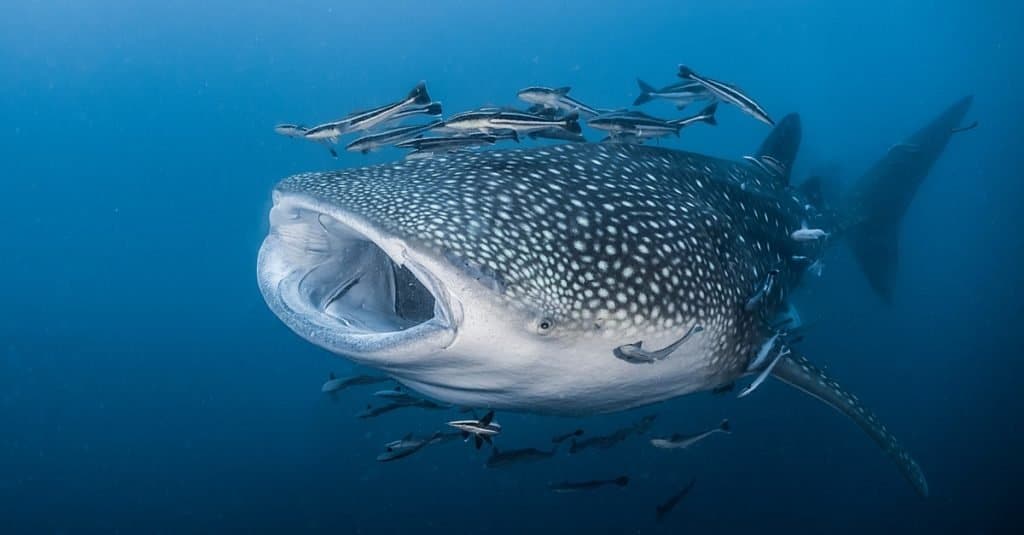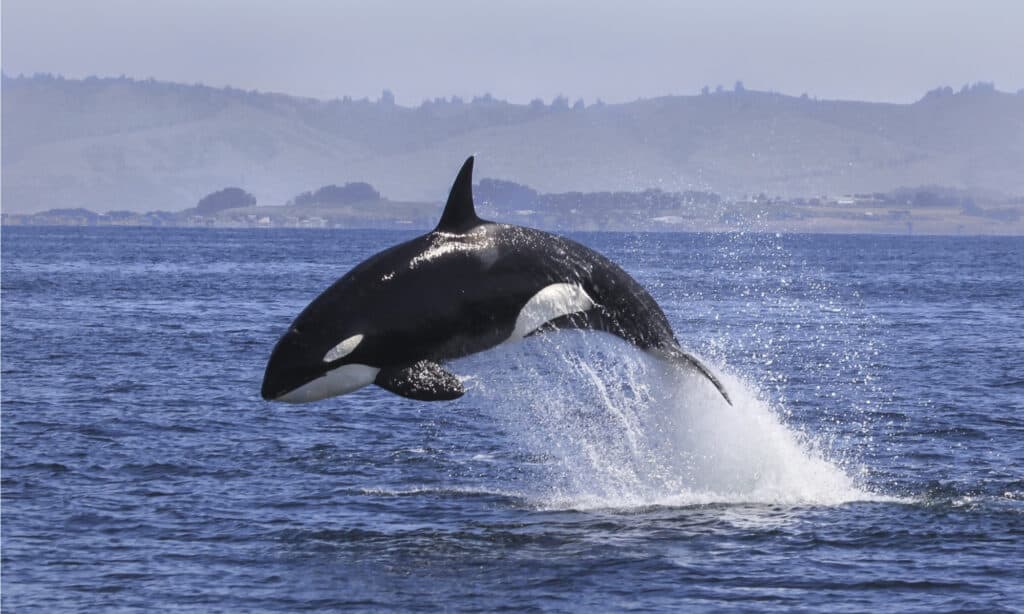The whale shark, scientifically named Rhincodon typus, belongs to the Genus Rhincodon and is reputedly the largest fish species in the world. On the other hand, the orca, also known as the killer whale, bears the scientific name “Orcinus orca” and belongs to the genus “Orcinus” of the Delphinidae family. While the orca is a marine mammal, the whale shark is the biggest fish in the world. How do these animals differ from each other? Let’s find out below.
Comparing the Whale Shark and Orca
| Whale Shark | Orca | |
|---|---|---|
| Size | Length: 32 ft average, can reach 60 ft Weight: 15 to 20 tons | Length: Up to 32 ft Weight: 7 tons on average |
| Appearance | Spindle-shaped bodies, three ridges along the dorsal sides; broad/flat head | Stream-lined bodies with black and white coloration |
| Location and Habitat | Location: Tropical seas around the world Habitat: coastal zones with plenty of food. | Location: Oceans worldwide Habitat: deep and shallow waters; may migrate to zones with lots of food |
| Diet | Carnivorous; krill, jellyfish, sardines, anchovies, mackerels, squids, and other plankton and nektons. | Carnivorous; sea lions, sharks, smaller dolphins, squids, sea turtles, river otters, etc. |
| Lifespan | 60 to 70 years | 50 to 60 years |
The Key Differences Between the Whale Shark and the Orca
The main differences between the whale shark and the orca lie in their size, appearance, and even diets, as we are about to see.
Whale Shark Vs Orca: Size

Whale sharks can measure up to 60 feet long.
©Onusa Putapitak/Shutterstock.com
The whale shark and the orca are both massive creatures and that much is evident in their length and weight figures. The whale shark has a length of about 32ft on average and weighs up to 20 tons. Some individuals have been observed to reach up to 60ft in length and about 60 tons in weight. The orca, on the other hand, measures between 23-32 ft in length while averaging about 15,000lbs in weight. These figures show that the whale shark is, by far, the weightier creature and also beats the orca in average length.
Whale Shark Vs Orca: Appearance

The whale shark is known for its typically fusiform body, wide/flattened head, and three ridges on its dorsal sides.
©iStock.com/crisod
The whale shark and the orca also differ in appearance, and telling them apart becomes easy once you get acquainted with their distinctive features. The whale shark is known for its typically fusiform body, wide/flattened head, three ridges on its dorsal sides, and a mouth with up to 300 rows of tiny/fragile teeth. They also have nares, in front of their snouts, but without the circumnarial folds found in some other shark species. Their skins are covered in tooth-like scale structures and their skeletons notably have no rib cages which significantly dwindles their weights. Coloration is mostly stable across the whale shark’s lifespan and varies across shades of blue, brown, and gray.
Orcas, on the other hand, have more straightforward features and are very easy to identify, thanks to their streamlined, black-and-white bodies. The dorsal surface is all black while the ventral surface has a mostly white coloration. There is a gray saddle spot behind their dorsal fins and the erect dorsal fins in males are much larger than those in females and immature males. These fins notably extend and curve either to the right or the left side.
Whale Shark Vs Orca: Location and Habitat
The whale shark is a migratory species found in tropical seas around the world. They prefer surface waters between 21°C and 30°C and can dive to depths of over 5000 ft. Interestingly, they can also withstand temperatures as low as 7.6°C and are comfortable in shallow waters as well.
Orcas, on the other hand, are found in oceans around the world, northwards as far as the Arctic Ocean and southwards as far as the Antarctic Ocean. They are not nearly as migratory as killer whales as they only move when their areas suffer food scarcity. They prefer waters with average depths of 196 ft and can dive to depths of up to 825 ft, usually in search of food.
Whale Shark Vs Orca: Diet

Orcas include sea otters, seals, and sea turtles in their diet.
©Tory Kallman/Shutterstock.com
As you have probably guessed, the whale shark and the orca are both carnivorous species, however, some differences occur in their actual food preferences. Whale sharks prefer a range of plankton and nektons including krills (favorite), jellyfishes, anchovies, mackerels, sardines, and squids, among others.
Orcas, on the other hand, go for larger sea creatures like sea otters, seals, sea turtles, sharks, small dolphins, and whales, among others. They may also settle for squids and small fishes. This incredible diet range further lends credence to the fact that orcas consume up to 300 pounds of food daily.
Whale Shark Vs Orca: Gestation Period and Litter Size
For a while now, scientists have been limited in their understanding of the reproductive process of whale sharks due to insufficient data. However, a painstaking study has revealed that whale sharks are polygynandrous, which means they often have multiple mating partners. Scientists also opine that whale sharks may take up to 30 years to reach sexual maturity. They are also ovoviviparous, which means the eggs hatch right inside of the mother. However, once the pups are born, the mothers show little or no care, and the pups are often left to fend for themselves. Whale sharks have an average litter size of 12 young.
In a similar fashion, orcas are also polygynandrous and most of their breeding is done in the summer. Their females reach sexual maturity between 6-10 years of age and gestation lasts between 15-18 months. It would interest you to note that the average litter size of orcas is one, which means they mostly give birth to one calf. Records show that orcas have only given birth to twins once in history. They are also more hands-on with their newborns, and studies show that they nurse their kids for up to 12 months.
Whale Shark Vs Orca: Lifespan
There is very limited information about the lifespan of whale sharks but scientists believe they live up to 100 years or more in the wild.
There is, however, more lifespan information about orcas, most of which affirm that females live almost twice as long as males. Female orcas are expected to live for about 63 years while males do not go beyond 36 years.
Up Next:
- Whale Shark Location: Where Do Whale Sharks Live?
- Are Whale Sharks Dangerous Or Aggressive?
- Are Killer Whales (Orcas) Dangerous?
The photo featured at the top of this post is ©
Thank you for reading! Have some feedback for us? Contact the AZ Animals editorial team.







